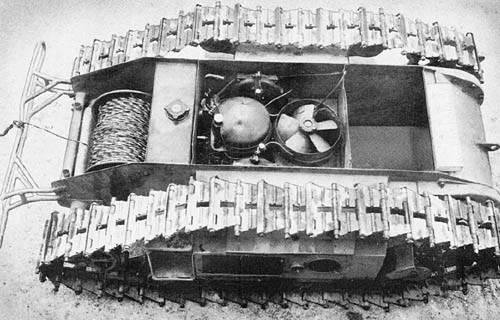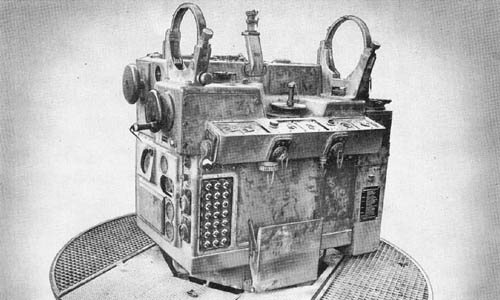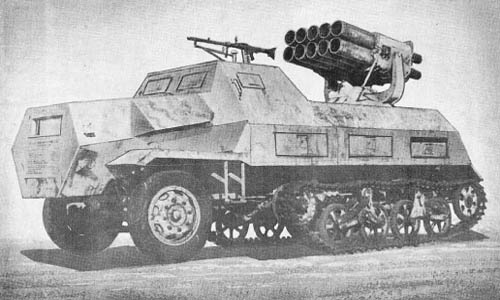
This miniature tank, weighing less than 700 pounds, is controlled by a 2000-foot electric cable from a hand control box carried in the rear. It is used to send a demolition charge to a point at which detonation destroys the tank as well as the target. The hull is fabricated from a mild 16 gauge steel with front upper and lower sloping plates 9 mm thick. These are set at 48 degrees and 50 degrees to the vertical. The hull contains three compartments. The rear compartment houses the cable and drum; the central compartment houses the power unit and control mechanism; and the front compartment contains the high explosive charge.
The power plant consists of a 2-cylinder, 2-cycle air-cooled engine. Ignition is by coil and 6 volt battery. The power is transferred through chain drives to each track by means of electromagnetic clutches. The total reduction from the clutches to the sprocket is 9.33:1. Steering is accomplished by breaking the circuit to the side to which the turn is to be made. This releases the magnetic clutch, cutting the power from the engine for that side of the vehicle. The suspension consists of five small bogie wheels on the bottom with two return rollers on top, and an idler wheel at the rear. Each bogie is independently sprung by coil springs. The chain driven sprocket is at the front of the vehicle. The track is 6 5/16 inches wide, with a simple grouser placed on every other track pin.
This vehicle carries an estimated 100-125 pounds of explosive, and has sufficient power to operate on practically all types of terrain. The control cable consists of three strands, in pairs, two for steering, and the third for setting off the detonator. In operation, the engines are started by a hand crank, the clutches engaged, and the tank then handled from the control box through the cable. Another version of this tank is powered by two electric motors.
SPECIFICATIONS
| Weight | 650 lbs. | |
| Length | 5 ft., 3 ins. | |
| Width | 2 ft., 10 ins. | |
| Height | 2 ft. | |
| Ground clearance | 5 1/4 ins. | |
| Tread centers | 2 ft., 3 ins. | |
| Ground contact | 2 ft., 6 1/2 ins. | |
| Width of track | 6 5/16 ins. | |
| Pitch of track | 2 13/16 ins. | |
| Track links | 47 | |
| Theoretical radius of action | 770 yds. | |
| Speed | 4 to 6 m.p.h. | |
| Armor | ||
| Front plate (upper and lower nose) | 9 mm | |
| Hull | 16 gauge steel | |
| Armament | (100-125 est.) pound explosive charge | |
| Engine | Inline 2 cylinder, 2 cycle | |
| Transmission | Chain drive, through electric magnetic clutch. | |
| Steering | Controlled by two electric clutches |
German: p. 40.1 (April 1, 1945)

